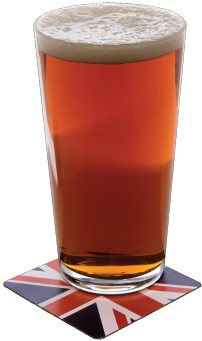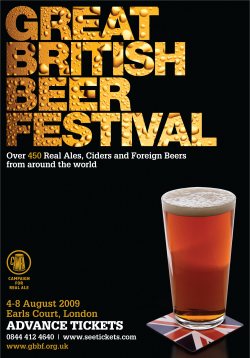| |
get hip - the Real Ale way
by Willard Clarke, 07/09
|
Hands up if you think real ale is drunk by old codgers in flat caps who keep whippets in the bath or by men of indeterminate age with bird's nest beards and bellies bigger than the national debt.
The stereotypes, assiduously peddled by Private Eye and Viz magazine for decades, never were accurate. They are even less true today. Real ale is the only sector of the brewing industry showing signs of growth and it�s increasingly popular with young people of both sexes.
The real ale revival seems at first a paradox. Total sales of beer in Britain are declining by 8% a year. Pubs are closing at the alarming rate of 40 a week. Yet membership of Camra, the Campaign for Real Ale, is booming and the annual Great British Beer Festival at Earl�s Court in August will be awash with good beer from independent craft brewers, whose numbers grow year by year.
One reason pubs close is that their owners don�t offer the range of beers modern consumers want. Camra beer festivals, on the other hand, are showcases for beers from old-established family brewers to the new wave of micros.
|
|

|
More than 200 new breweries have fired their mash tuns and coppers in the past four years. The total number of breweries in Britain now stands at 668, more than twice the number when Camra was launched in the 1970s.
There has never been greater choice for beer drinkers. Real ale today is about far more than just pints of mild and bitter. Golden ales, summer beers, harvest ales, barley wines, India Pale Ales, porters, stouts and oak-aged beers bring a diversity to the beer scene unknown 30 years ago
The paradox is explained by stripping out the beer sales of the global giants that dominate British brewing. They are all foreign-owned: this is not a jingoistic point, just a fact of life. Companies such as Heineken, which owns Scottish & Newcastle, Coors from Colorado that bought the former Bass breweries in Burton-on-Trent, Carlsberg of Denmark, and the world�s biggest brewer A-B InBev, an ungainly merger of American Budweiser, Ambev of Brazil and Stella Artois of Belgium, are lager brewers with little or no interest in real ale.
Sales of global lager brands are in decline. People have grown tired of drinking the advertising and are wary of beers that are trunked thousands of miles to pubs and which are made from rice and maize rather than traditional barley.
As every economist knows, it�s possible to grow a sector within an overall declining market. The Society of Independent Brewers, the umbrella body for Britain�s craft brewers, estimates that its members� sales are growing by between 10 and 11% a year. The giant brewers will scoff and say they spill more beer than the independents make, but it�s the giants� sales that are in decline and real ale that�s on the increase.
The demand, even clamour, for real ale coincides with a wider consumer demand for natural food and drink. Craft brewers have responded to this demand by giving detailed information about the malts and the hops they use, using home-grown ingredients wherever possible.
As a result, beer drinkers today can be as knowledgeable about ingredients as wine connoisseurs. With a little experience, it�s possible to tell the aggressive spicy and peppery character of English Fuggles and Goldings hops to the more restrained floral and piny approach of German varieties and the unrestrained citrus/grapefruit attack of American breeds.
Some of the finest malting barley is grown in England, mainly in the East Anglian grain basket. Craft brewers relish in particular Maris Otter barley with its luscious juicy and biscuity character. One major malting company, Warminster in Wiltshire, supplies malt made from Maris Otter from named farmers and individually numbered fields: if a brewer likes a particular batch of malt he can order it from the same farmer the following year.

|
|
Camra members are equally aware of the need to "drink local". Two years ago, a lone member in Nottingham called Steve Westby thought of a scheme he called LocAle to boost the fortunes of small brewers and to make a contribution to combating global warming. Westby was encouraged by Camra research that showed that the transport of food and drink accounts for 25% of all heavy goods vehicle miles in Britain. If you take into account the miles ingredients have to travel on top of distribution journeys, an imported lager produced by a multi-national brewery can notch up more than 24,000 "beer miles" before reaching a pub or supermarket.
|
Westby�s LocAle scheme simply asks publicans � in return for special window sticker � to order at least one cask beer from a brewery not more than 20 miles away. He argues that buying locally not only saves on beer miles but boosts local economies, services and jobs.
LocAle has taken off like a proverbial steam train and is now supported by Camra branches and pub owners throughout the country. The impact of the scheme can be seen at first-hand in Camra�s National Pub of the Year for 2009, the Kelham Island Tavern in Sheffield. A once-rundown and semi-derelict pub in a post-industrial part of the city, the tavern now thrives and draws real ale lovers like a magnet from far and near.
Owner Trevor Wraith says 90% of his beer sales are accounted for by real ale � 40% would be considered high by many publicans. His experience mirrors that of the industry-sponsored body Cask Marque, which monitors the quality of real ale in pubs. It finds that pubs that promote a good range of real ale will see trade grow by 14%, while pubs that offer no cask beer are recording a sales fall of
2.5%.
In the Kelham Island Tavern, Trevor Wraith draws his beers from south Yorkshire and the neighbouring Peak District. Some beers come not 20 miles away but a few hundred yards from the new Sheffield Brewing Company, based in part of the former Blanco polish factory.
I found no flat caps, whippets or beer bellies in the Kelham Island Tavern, just a cross-section of pubgoers, men and women, who revel in full-flavoured beer. Women are increasingly drawn to the pleasures of cask beer. For the second year running, the Great British Beer Festival will stage a conducted tour of the site with beer tastings for women visitors. The event will be hosted by beer writer Melissa Cole. Cole says bluntly that if women say they don�t like beer then �they�re drinking the wrong sort of beer�. She will introduce her guests to the wide range on show and will prove that not all real ales are so hoppy and bitter they blow your ears off.
Camra, once as male dominated as the members� pavilion at Lord�s, now has a quarter of its ranks filled by women. The current national chairman is a woman, the formidable Paula Waters, while three women have taken on the daunting task of running the Great British Beer Festival in recent years. Students are on Camra�s radar, too. Gus Manning, a graduate from Nottingham, leads a team of students that sets up university real ale societies and busily recruits young people to the campaign.
You don�t have to be tiny to be a craft brewer. Large national independents such as Marston�s of Burton-on-Trent, Greene King in Suffolk and Wells & Young�s in Bedford each produce around half a million barrels of beer a year, a large proportion of it in cask form. Greene King�s IPA is the biggest-selling standard bitter in the country, while Marston�s Pedigree and Wells� Bombardier are two of the top five premium brands.
While many craft breweries are content to remain small and just supply a local market, others are growing to meet demand. By the time the Camra beer festival opens on 4 August, the Thornbridge Brewery in Derbyshire will have moved from cramped garden buildings in the grounds of Thornbridge Hall to a new state-of-the-art plant at nearby Bakewell.
| Jim Harrison, owner of the hall with his wife Emma, is a beer lover who has used part of his fortune to revive the habit of stately houses having their own small breweries. Thornbridge has won such acclaim for its Jaipur IPA � winner of 48 awards in four years � and St Petersburg Imperial Russian Stout that greatly increased facilities were required. The new brewery has cost �1.6 million, will have a capacity of 30,000 barrels a year and sufficient space to install additional fermenting vessels as the need arises.
In another picturesque setting in the Lake District, former top BBC correspondent Alex Brodie has also notched up a remarkable success with his Hawkshead Brewery. When Brodie put down his microphone and picked up his malt shovel in 2002, he brewed a few barrels a week in converted barns near Hawkshead. Four year later he moved to new premises at Staveley Mill, with a 20-barrel plant. As well as a brewery, it�s a visitor centre, with a shop and a bar where drinkers can view the brewery and see beer being made. The range includes a deliciously hoppy Lakeland Gold and, naturally, a strong ale called Brodie�s Pride.
|
|

|
Moorhouse�s Brewery is also in the north-west but in the less glamorous setting of Burnley. Its success proves that breweries can thrive in towns that have lost their industries. Like the mills, Moorhouse�s was on the point of closure in the 1990s but was saved when it won the coveted Camra Champion Beer of Britain award in 2000 for its Black Cat mild ale. Driven by that success and sales of its strong bitter Pendle Witches Brew, Moorhouse�s is now building a new brewery in Burnley that will be capable of producing 40,000 barrels a year. That is a figure that will move it from the ranks of a micro to a fully-fledged large regional brewery.
The craft brewing sector is a great innovator. Brewers have dug deep into old recipe books to revive genuine India Pale Ales, porters, stouts and barley wines. But they look to the future as well. A host of golden ales, rich with juicy malt and tangy hops, are aimed primarily at younger drinkers, proof that pale beers can be full of flavour, unlike the fizz of the British travesty of lager.
The most fascinating development is oak-aged beers. Fuller�s in London, Thornbridge in Derbyshire and several Scottish breweries are experimenting with maturing strong ales in oak casks bought from the whisky industry. They offer a scintillating fusion of beer and whisky, and Fuller�s Brewers Reserve, matured in Glenmorangie casks, is arguably the best new beer launched in recent years.
And the message may even be getting through to the global producers. Coors in Burton has found itself with an unexpected success on its hands. Worthington�s White Shield is a bottled version of India Pale Ale that dates from the 19th century. It�s suddenly in such demand � with massive sales in Sainsbury�s and with Asda and Waitrose knocking on the door -- that Coors will move production from a small pilot brewery into its main Burton plant, where 100,000 barrels a year can be produced.
That�s 100,000 barrels of a bottled beer that contains live yeast � real ale in a bottle. The beer worm has turned with a vengeance.
|
|